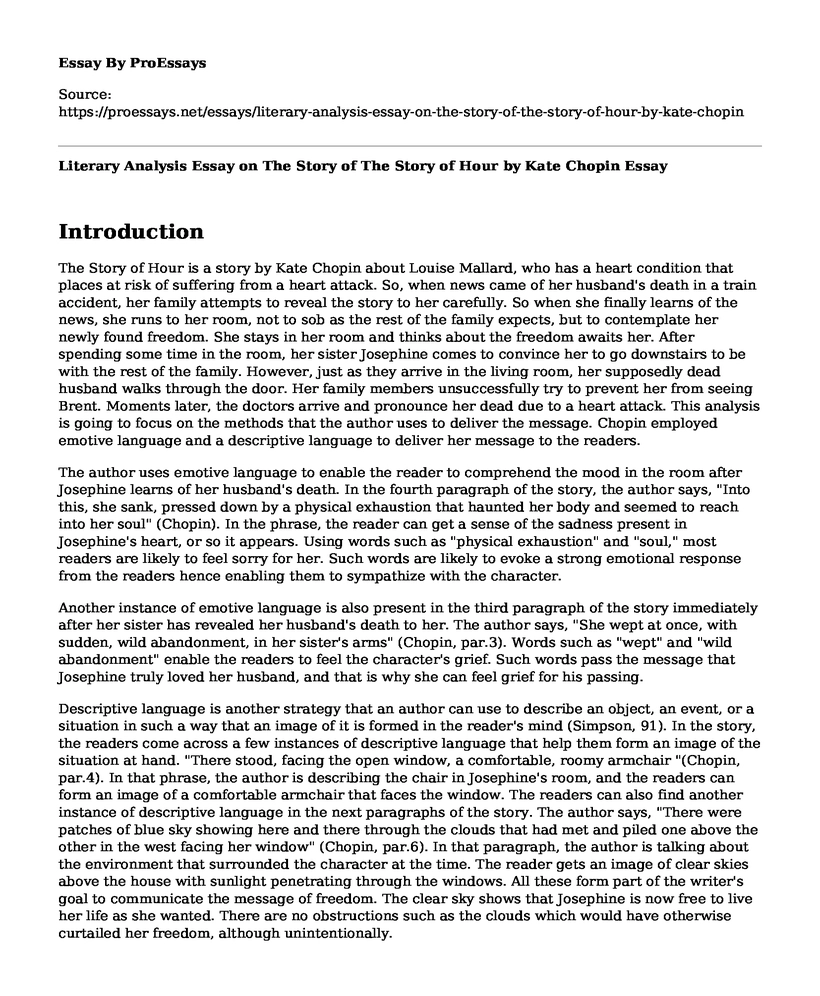Introduction
The Story of Hour is a story by Kate Chopin about Louise Mallard, who has a heart condition that places at risk of suffering from a heart attack. So, when news came of her husband's death in a train accident, her family attempts to reveal the story to her carefully. So when she finally learns of the news, she runs to her room, not to sob as the rest of the family expects, but to contemplate her newly found freedom. She stays in her room and thinks about the freedom awaits her. After spending some time in the room, her sister Josephine comes to convince her to go downstairs to be with the rest of the family. However, just as they arrive in the living room, her supposedly dead husband walks through the door. Her family members unsuccessfully try to prevent her from seeing Brent. Moments later, the doctors arrive and pronounce her dead due to a heart attack. This analysis is going to focus on the methods that the author uses to deliver the message. Chopin employed emotive language and a descriptive language to deliver her message to the readers.
The author uses emotive language to enable the reader to comprehend the mood in the room after Josephine learns of her husband's death. In the fourth paragraph of the story, the author says, "Into this, she sank, pressed down by a physical exhaustion that haunted her body and seemed to reach into her soul" (Chopin). In the phrase, the reader can get a sense of the sadness present in Josephine's heart, or so it appears. Using words such as "physical exhaustion" and "soul," most readers are likely to feel sorry for her. Such words are likely to evoke a strong emotional response from the readers hence enabling them to sympathize with the character.
Another instance of emotive language is also present in the third paragraph of the story immediately after her sister has revealed her husband's death to her. The author says, "She wept at once, with sudden, wild abandonment, in her sister's arms" (Chopin, par.3). Words such as "wept" and "wild abandonment" enable the readers to feel the character's grief. Such words pass the message that Josephine truly loved her husband, and that is why she can feel grief for his passing.
Descriptive language is another strategy that an author can use to describe an object, an event, or a situation in such a way that an image of it is formed in the reader's mind (Simpson, 91). In the story, the readers come across a few instances of descriptive language that help them form an image of the situation at hand. "There stood, facing the open window, a comfortable, roomy armchair "(Chopin, par.4). In that phrase, the author is describing the chair in Josephine's room, and the readers can form an image of a comfortable armchair that faces the window. The readers can also find another instance of descriptive language in the next paragraphs of the story. The author says, "There were patches of blue sky showing here and there through the clouds that had met and piled one above the other in the west facing her window" (Chopin, par.6). In that paragraph, the author is talking about the environment that surrounded the character at the time. The reader gets an image of clear skies above the house with sunlight penetrating through the windows. All these form part of the writer's goal to communicate the message of freedom. The clear sky shows that Josephine is now free to live her life as she wanted. There are no obstructions such as the clouds which would have otherwise curtailed her freedom, although unintentionally.
The use of descriptive and emotive language represents a small number of the strategies employed by the author to deliver her message. Such strategies are necessary for the writer to communicate her message to the reader. Emotive language enables the reader to sympathize with the character or situation described. While descriptive language enables the reader to develop an image of the object, character or situation being described, it is through such strategies that the reader understands that Josephine's death might not have been as a result of happiness.
Works Cited
Chopin, Kate. The Story of an Hour. Perfection Learning, 2001.
Simpson, Paul. Language, ideology, and point of view. Routledge, 2003.
Cite this page
Literary Analysis Essay on The Story of The Story of Hour by Kate Chopin . (2023, Apr 08). Retrieved from https://proessays.net/essays/literary-analysis-essay-on-the-story-of-the-story-of-hour-by-kate-chopin
If you are the original author of this essay and no longer wish to have it published on the ProEssays website, please click below to request its removal:
- The Canterbury Tales of General Prologue Analysis
- Themes of Freedom and Racism in Oroonoko Essay
- Essay on Charlotte Perkins Gilman's the Yellow Wallpaper
- Assignment Example on German Romanticism
- Book Review Sample on Caucasia: Danzy Senna's Fictional Exploration of Race & Discrimination
- Bravery and Courage in Neil Gaiman's Coraline - Free Paper Sample
- Identity in the House on Mango Street - Essay Sample







